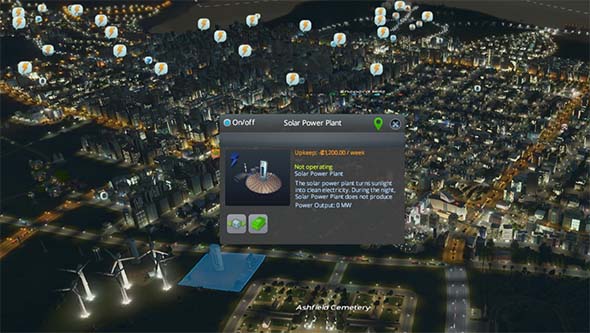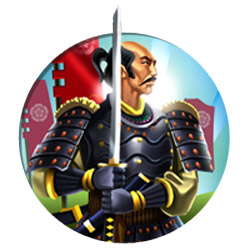
It's been a very long time since I've had a city-building game that I really enjoy. So it was a real treat to find Cities: Skylines last year. It was the first game to really capture the magic of the classic SimCity games and make them work in full 3-D, and managed to achieve the goal of abstract population agency that the SimCity reboot failed so horribly at. But as much as I loved Skylines, I was also very aware of many of its limitations. It didn't have as much content as you might expect from a game coming from a larger publisher (like EA), and there were certain elements of its abstraction that felt a little shallow or weird. The game's first expansion, After Dark, tries to address these limitations, but it doesn't really succeed.
The free update is a nice gesture, but ...
First and foremost, I have to clarify exactly what the expansion encompasses, since Colossal Order has created a bit of confusion on this topic. They launched a free update for the base Cities: Skylines game in parallel with the release of the After Dark expansion. This update included some of the core feature upgrades that the expansion's content depended on. Most notably, a day/night cycle, new zoned buildings, and upgraded crime systems. If you have Cities: Skylines, then you get these features as a free patch, and have probably been playing with them for months.

The day/night cycle is a free upgrade to the core game, but makes the core game feel somewhat incomplete.
While I applaud Colossal Order for the good will they foster by being willing to give away new functionality for free, this does kind of put players of the vanilla game in a strange situation. You get some of the new features, but not any of the ploppable buildings or city policy options that make them work. You get more crime, but not the prisons in which to lock up and rehabilitate criminals. You get the day/night cycle, but not the fancy new leisure and tourism zones that make nighttime mechanically relevant. In some ways, it takes the core game that felt very complete on its own, and suddenly makes it feel incomplete in subtle ways.
Fortunately, the menu gives you the option to turn the day/night cycle off, which helps to preserve the integrity of the original game. But then you don't get the new feature.
The update won't harm any of your existing save files though - with one major exception. If you made the unfortunate mistake of creating a city that was completely dependent on solar power, then the day/night cycle will screw that city over big time! In the core game, this was actually the most optimal way to go. Solar didn't pollute, wasn't dependent on depleting resources, and money was easy enough to make that the cost wasn't a big enough deterrent to using solar. But with the day/night update, once the sun goes down, all those fancy, expensive solar panels completely stop working! This can lead to your entire city going into a blackout as soon as you boot up your save file. Suddenly, not only is solar non-optimal, but it's practically useless since it doesn't work for half the game. And this isn't something that you can fix by just increasing solar power funding or building more plants; the power output drops to zero!

Solar power plants stop working completely during the night, leading to massive blackouts.
Fun at night, and in the sun
I did complain somewhat about the lack of a day-night cycle in the base game, but the implementation that Colossal Order gave us is a bit uncomfortable and awkward. The rapid progress of a "day" in the game means that they couldn't transition from day to night in a single game-day, or else the game would just be constantly flickering between day and night. The developers apparently didn't want to slow down the game-day either, since that would probably upset many elements of the game's economic and agent systems. So instead, your cities get about a month-and-a-half of day, followed by about a month-and-a-half of night. Individual citizens seem to go about a daily cycle within this time. They aren't bound to it though. I've seen some citizens go back and forth between home and a near-by job several times during the day-time, then spend the whole night out at a restaurant or nightclub; and other citizens can spend the entire daytime commuting to and from work only to spend most of the night sitting in the office. They start their cycles at staggered times during the day; thus, sparing us from the annoying pathfinding and gridlock issues that plagued SimCity (2013). It all ... works ... at a very abstract level; it just feels weird... [More]
f5d3fc25-4e52-471a-a9cb-17667d979a88|2|3.5
Tags:Cities: Skylines, Cities: Skylines: After Dark, Paradox Interactive, Colossal Order Ltd., PC, expansion, Steam, Steam Workshop, city simulation, day, night, tourism, leisure, beach, hotel, nightclub

With Starships released, an expansion for Beyond Earth announced, and support for Civ V apparently done, I thought it would be a good time to take a look back at the game. I'm going to spend a few posts to discuss what Civ V did right, and what it did wrong, so that future games can learn lessons from this iteration's successes and failures.
Here I will present a Top 10 list of my favorite new features, mechanics, and design philosophies in Sid Meier's Civilization V (and its two expansion). These are the elements of the game that stood out the most to me as contributing to the fun and addictiveness of the game, and which push the series in positive directions. Most of these features are things that I would probably like to see return in future sequels.
But even though my intent here is to shine glowing praise on Civ V, I'm not going to ignore the faults of even my favorite features. Some of these mechanics are great ideas, but still suffered from problems in execution. So I won't shy away from constructive criticism where applicable, and I'll make recommendations to improve these great features in the future.
In a future post, I will also look at the things that Civ V got wrong.
Of course, any list of "good ideas" or "bad ideas" is going to be subjective. You may not agree with my opinions, and that's OK. If there's any features, mechanics, or design decisions that you really love in Civilization V, its DLC, or its two expansions, please feel free to leave a comment!
... [More]
e0c9eca7-cd83-4140-a7a1-718f8ff1627f|0|.0
Tags:Civilization V: Brave New World, retrospective, Sid Meier's Civilization, civilization, top 10, Civilization V: Gods & Kings, religion, pact of secrecy, diplomacy, tactics, social policies, resource, archaeology, tourism, natural wonder, city state, great work, Civilization V

Continuing my series of strategy posts about Brave New World's modified civilizations, I'm going to take a look at strategies for Oda Nobunaga's Japan. Since Brave New World's Fall patch Japan was given additional buffs towards culture and coastal starts.
Japan is a series of four large island and numerous smaller islands that were formed by volcanoes. It has been inhabited since the upper paleolithic era (about 30 thousand years ago), and its people have lived in relative isolation for much of its history. It has gone through periods of war with its closest neighbors across the sea: China and Korea, and has had significant cultural influences from both, such native Shinto's two competing religions: Buddhism and Confucianism. Throughout most of Japanese history, the country has been in a feudal state, with regional populations being loyal to a warlord who is granted land and titles from the emperor (or "Shogun"). In-fighting between warlords was common, and power often ebbed and flowed between different clans and families.

Samurai Daimyo Oda Nobunaga helped Ashikaga Yoshiaki to reclaim the title of Shogun for his clan in 1568, and Nobunaga used the leader as a puppet to enable his own conquests. He was a brutal warrior who once set fire to an enemy complex, killing tens of thousands of civilian non-combatants (including women and children) in order to put down a rebellion of farmers and monks. He eventually attained military control of more than half of the territories of Japan on behalf of the Shogun. His successor, Hashiba Hideyoshi, would complete the unification of Japan 11 years after political and personal tensions lead to Nobunaga's assassination by a vassal clan.
In the 19th century, Japan's isolation finally ended and it began the process of rapidly modernizing. By the 1930's, Japan had developed into a modern military-industrial machine that was almost the technological equivalent of the United States and European powers. It became the dominant power in the Pacific prior to being defeated by the United States in the second half of World War II. [More]
1cad9ae0-1148-4d92-80d2-cc7859222fda|3|5.0
Tags:Sid Meier's Civilization, Civilization V: Brave New World, Civilization V, Japan, Oda Nobunaga, Bushido, daimyo, shogun, Zero, culture, tourism, sea resources, fishing boats, sushi, longswordsman, fighter, warmonger, samurai, Civ V Fall Patch, Civ-V

Continuing my series of strategies for Brave New World, I am going to take a moment to discuss one of (if not the) most sorely misunderstood civilizations from the vanilla game: Gandhi's India. India received a very minor tweak in Brave New World (its unique building was modified to provide tourism instead of gold), but the new trade route mechanics radically change the way that India should be played. In some ways, the new features make India feel like a completely new civilization!
The ancient civilization of India is one of the world's most populace and diverse countries. More than 1/6th of the world's population currently calls India home (that's over a billion people!), it is one of the cultural and spiritual centers of the world. India is the birthplace of both the Hindu and Buddhist religions, which make up third and fourth most populous religions today. The less-populous faith of Jainism also has roots in India. In addition to the variety of religions, there are also over 100 distinct languages that are spoken in India! Indian society used to follow a rigid caste system in which a person's status in life is determined at birth. Although this caste system is not enforced (and is actively discouraged by the government), it remains a persistent force in the nation, and still leads to a great deal of prejudice and conflict within the country.

One of the most significant leaders of Indian history (and world history) is Mohandas Gandhi. In the early 1900's, India was under British occupation, and Gandhi, the son of the Prime Minister of the small state of Porbandar, was successful in leading an unprecedented non-violent rebellion to drive the foreign rule out. This peaceful rebellion lead to Gandhi being recognized as one of the most courageous and moral leaders the world has ever known. Indians affectionately refer to him as "Bapu" (translation: "father") in recognition of his role in creating the modern Indian nation. His birthday, October 2, is a national holiday in India, and is celebrated outside of India as the International Day of Non-Violence. Sadly, he was assassinated in 1948 (at age 78) by a Hindu nationalist who believed that Gandhi showed too much favoritism to Pakistan, one of India's bitter rivals. The assassin was tried and executed the following year, and Gandhi's ashes were distributed around the country for numerous memorial services.
Gandhi's representation in Civilization V gets a lot of undeserved criticism from some players, who often cite India as the "worst civ in the game" based solely on the fact that he is the only civ with a penalty explicitly stated in his unique ability (except for Venice in Brave New World), and that his unique unit is in some ways inferior to the unit it replaces. However, it is important to note right off the bat that there are plenty of civs who receive indirect penalties as part of their uniques. But the "Population Growth" ability, itself, is very poorly understood. Many players assume that this means that India must be played with a small empire, and that India cannot compete for any victory except for culture or diplomatic. This is simply not the case, and I'm going to explain why! [More]
53e37110-4392-460c-901d-be3ce7603441|9|4.9
Tags:Sid Meier's Civilization, Civilization V: Brave New World, Civilization V, Gandhi, India, Population Growth, War Elephant, Mughal Fort, tourism, trade route, chariot archer, castle, happiness, unhappiness, cities, PolyCast, atomic bomb, nuclear missile, nukes, ranged mounted unit, Civ-V

In one of my earlier posts titled "'Silent Hill' is NOT about 'repressed guilt'; it's about occultism!", there seemed to be some misunderstandings about the interpretations that I offered. For one thing, reader Malik commented:
"I have to disagree. The series has never established the cult as the basis for the goings-on in Silent Hill. It is never explicitly stated that the cult or Alessa are the true source of the supernatural power ..."
The commentor is correct on that point. Though, I don't think I ever said that Alessa and the cult were the ultimate source. If you got that impression, then there might have been a misunderstanding or miscommunication, and I apologize for not being clear. To be clear: I was arguing that the plots of the game were focused on the cult and Alessa, and how they affected this supernatural power -- not that the cult is the cause of the power. I thought about responding with my own comment on that original post, but I felt that it would be more appropriate to just write a new blog article about it, so that I could spend more time exploring the town's history, as it was established by the original creators. So, Malik, I hope you read this. and I hope it makes more sense. I'd love to hear your feedback.
Please note that much of this post is speculation. The games themselves provide very little concrete information about the extended history of the cult and region -- especially prior to the Civil War. The following is all retroactive explanation and may not represent the original intentions of the creators. This will be my own, personal opinion and interpretation regarding the nature of Silent Hill's otherworldly power.
The Place of the Silent Spirits
I never intended to imply that the cult and Alessa created the supernatural phenomena, nor that they are the power's ultimate source. I agree that the power likely existed (in some form) far prior to the events of the first game.

Mary refers to Silent Hill as a "sacred place".
Mary's comments regarding the place being "sacred" in the past implies that early inhabitants (probably the Native Americans) were aware of the supernatural effects of the region going back hundreds - maybe thousands - of years. Since the Natives saw the place as being "sacred" and beautiful, I tend to believe that the power did not originally manifest demons or project people's nightmares onto reality during these periods of history. Instead, I would imagine that the force (whether conscious or not) would have been more benign - maybe even benevolent.
We don't know much about the natives' beliefs prior to the arrival of European colonists, and what little we do know is possibly clouded by the lens of the European colonists and cultists.
Based on what is known about real-world Native American beliefs, it is probably safe to assume that the natives of the Toluca Lake region would likely have worshipped any regional supernatural power as "ancestral spirits" or as "spirits of nature". The Book of Lost Memories can be found in Silent Hill 2 after beating the game, and it supports this idea and tells us about the nature spirits:

"They called this place 'The Place
of the Silent Spirits'. By 'spirits',
they meant not only their dead
relatives, but also the spirits that
they believed inhabited the trees,
rocks and water around them."
- Lost Memories book (Silent Hill 2)
The name "Place of the Silent Spirits" may simply be an innocent callback to the game's title, or it could be a significant clue. The fact that the spirits were "silent" implies that the natives were not able to talk to it; or at least, the spirits did not talk back. This implies that the "spirits" are probably not a conscious entity. Even though it can apparently react to the thoughts - and even desires - of the people it comes in contact with, it may not have an intelligence or will of its own (which I explained in my earlier post about repressed guilt)... [More]
643444f5-4ba4-4d6c-818b-921ecc1c7154|8|5.0
Tags:Silent Hill, Silent Hill 2, Silent Hill 3, Silent Hill 4: the Room, history, cult, occult, black magic, religion, spirituality, Christianity, Satan, god, Native Americans, Glooscap, Otherworld, paradise, Maine, colony, Civil War, colonial America, Toluca Lake, tourism, drugs
|

| 12 | | | | | | | 60 | | 11 | | | | | | | 55 | | 10 | | | | | | | 50 | | 09 | | | | | | | 45 | | 08 | | | | | | | 40 | | 07 | | | | | | | 35 | | 06 | | | | | | | 30 | | 05 | | | | | | | 25 | | 04 | | | | | | | 20 | | 03 | | | | | | | 15 | | 02 | | | | | | | 10 | | 01 | | | | | | | 05 |
|